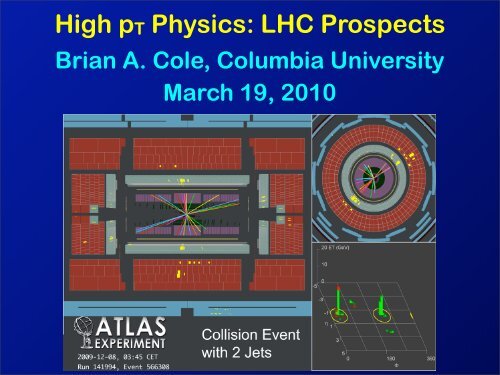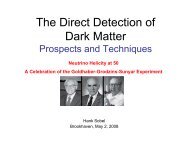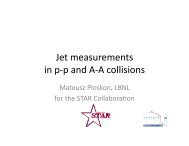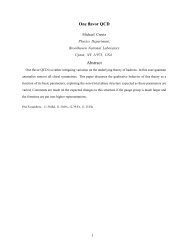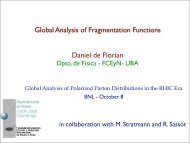Brian A. Cole - Thy Phy Bnl
Brian A. Cole - Thy Phy Bnl
Brian A. Cole - Thy Phy Bnl
- No tags were found...
You also want an ePaper? Increase the reach of your titles
YUMPU automatically turns print PDFs into web optimized ePapers that Google loves.
High pT <strong>Phy</strong>sics: LHC Prospects<strong>Brian</strong> A. <strong>Cole</strong>, Columbia UniversityMarch 19, 2010
LHC High-pT <strong>Phy</strong>sics (Relevant to this meeting)While the primary focus of the LHC is onelectro-weak and BSM physics, the LHCwill be a powerful tool for studying QCD• Very high Q2 hard scattering processes– Production of many-jet final states, heavy flavor⇒ Tests of understanding of parton showers• Hard processes involving low-x partons– In p+p, tests for BFLK physics, diffractive hard physics(?)– In p+A, A+A, shadowing measurements, saturation tests⇒ (semi?)-hard QCD @ large parton densities• Jet quenching in A+A– Extended jet pT range , higher jet yields– Jet measurements at very large Q 2⇒ Modification of extended parton showers in medium2
CMS Event Display3
ATLAS Event Display4
5Picturing (and understanding) high-pT physics• RHIC community hasbeen conditioned byexposure to cartoons orschematics of physicsapplicable only at LO⇒Mea Culpa– Even in hard processesQCD is more complicated
Picturing (and understanding) high-pT physicsVirtuality evolution:low → high resolution• Copious radiation by all color charges– Angular ordered initial, final state parton showers⇒ For high-Q 2 processes, hard radiation (jets) in → shower– Subtle physics in QCD description of soft radiation6
7Picturing (and understanding) high-pT physics2 jet event (?) 3 jet event (?) 2, 3, ? jet event• There is no unique relationbetween diagrams andnumbers of jets• There is no unique separationbetween the hard scatteringand the parton shower(s)Where does “hard”scattering end and theparton shower(fragmentation) begin
CDF: Example Multi-jet event8
Picturing (and understanding) jetsRadiation extends over(beyond) full hemispherein jet directionColor connection betweenoutgoing partons andbetween those partons andbeam remnantsOverlap between initial, finalparton showers• Even theoretically, not possible to uniquely associatea “jet” (measured correlated collection of hadrons)with individual partons– NO such thing as a “true” (parton) jet cross-section9
Jet Definitions, angular coverageSTARp-p di-jet Event• Trade-offs in jet definition:– Larger angular coverage collects more of the jet⇒Smaller losses due to radiation (soft and hard)– Larger angular coverage increases overlap of showers⇒And increases contribution of underlying event• Changing angular scale can change # of jets10
Jet Algorithms, considerations• Jets defined by the algorithm• To be calculable in pQCDalgorithm should be– Collinear safe⇒Insensitive to small-θ splitting– Infrared safe⇒ #, position, energy of jetsinsensitive to soft hadrons– Well-defined procedure fordistinguishing between 1, 2 jetsat a given angular scale• In last 5 years:– Death of seeded cone, mid-point– New: SIScone, Anti-KT, +⇒SIS = Seedless, infrared safe11
12Sequential Recombination AlgorithmsR 2 φ i φ j2η i η j2d ij min k T i p , k T j p R 2d iBk T i pSequentially combine pairs ofparticles (“proto-jets”) accordingto smallest dijp = 1 - kT algorithm (QCD-like)p = -1 - anti-kT (cone-like)• Sequential recombination algorithms:– Infrared and collinear safe– Original kT algorithm motivated by angular-ordered PS– Anti-kT inspired twist to produce cone-like behavior⇒But without (less) ad-hoc split-merge
Different Jet Algorithms13
14(very) Preliminary LHC Jet Data: ATLAS• Reconstructed using anti-kT algorithm (R = 0.6)– ATLAS “topo-tower” algorithm (similar to D0 4-2-0)• Jet energies only at EM scale• ~ 10’s k jets reconstructed from first beam data
(very) Preliminary LHC Jet Data: CMSSalvatore Rappocio, Moriond (QCD) Talk• Anti-kT, R = 0.5• From left to right:– Calorimeter only, track-improved calo, particle flow⇒Track-improved & particle flow uses tracking,identification of neutral hadrons, photons, etc toimprove jet resolution.15
16ALICE, CMS Charged Particle SpectraFrom Jacek Otwinowski(ALICE) Moriod Talk• Non-single diffractive charged particle spectra⇒Note different pseudo-rapidity coverage
ATLAS Charged Particle Spectrum• Beware ATLAS event selection requirements– 3 tracks, pT > 0.15 GeV, 1 tracks, pT > 0.5 GeV17
18Jet Tomography in A+A Collisions• At RHIC, studied viahadrons (until recently!)leading– Statistics suffer from frag.function ⇒ rates– Quenching ⇒ geometric bias– No direct measure of frag. function.• At LHC:– Full jets, high p T , large rates, b jets, di-jet, γ-jet⇒Precision jet tomography
Understanding A+A Jet MeasurementsCanonical picture“Jet quenching” = mediummodified parton shower• Important to remember above discussion:– There is no unique “true jet” measurement (more so now)– Some of induced radiation will be outside jet (E loss)– The fragmentation of the jet will soften19
20Jet Quenching CalculationsparthadroEpR = 0.7 R = 0.4Zhang, VitevQuark Matter 2009•Big change inhadron angulardistribution due tomedium•Especiallyimportant forsmaller “cones”
Jet “Suppression”Vitev,Ratio of in-mediumto vacuum jet yield• Reduction in jet yield at given ET due to mediuminducedradiation outside the “cone”– Smaller jet larger suppresion, especially below 100 GeV⇒Significant effect for reasonable R ( < 0.4)21
22Modification of Fragmentation FunctionArmesto et alMedium modifiedD(z)Increasingmediumdensity• As long as some of induced radiation is “in cone”– “Jet” energy will include radiation⇒But fragmentation hadrons will be shifted down in pT⇒Suppressed fragmentation function @ large z
23Jet Modifications: ExpectationsWiedemann: Quark Matter 2009Densermedium•Expect softening and angular broadening offragmentation due to medium.
Jets in A+A: Underlying eventPb + Pb + 70 GeV jetPb + Pb + 70 GeV jetbackgroundsubtracted• Underlying event affects jet energy resolution• But, far worse, can produce false jets–Crucial issue for A+A jet measurements⇒ Important to optimize signal/background (smaller “R”) 24
ATLAS: Modified Fragmentation Func.ATLAS PreliminarypT > 2 GeV/cBackground =tracks fromunderlyingeventArmesto et almodified FFD(z)•Comparison of input hadron zdistribution to reconstructed–With tracking efficiency correction⇒But prior to corrections for jetenergy resolution25
CMS: γ-jet fragmentation functionPb+Pb 0-10% centrality, statistics for 0.5 nb -1quenchingRadiation/feed-down•Measure fragmentation function in jets opposite areconstructed photon using photon energy.–Δϕ > 172°, ET jet > 30 GeV, |η jet | < 2–Photon ET > 70 GeV26
True Jet measurements in progressSTAR(Au-Au)PHENIX(Cu+Cu) jeteventsSTAR Au+AuspectrumPHENIXCu+Cu dijetΔϕ
28<strong>Phy</strong>sics of jet quenching• Crucial question:– Does parton evolution inmedium look anything likea “normal” parton shower??• Attempt to distinguish– Weakly coupled radiative +collisional energy loss– Strongly coupled/nonperturbativequenching⇒Expect strong couplingeffects to produce “non-QCD-like” jets⇒Then should measurelarge jet suppression
Prospects• 7 TeV p-p– LHC magnets already being ramped to 3.5 TeV– 7 TeV operation on few week time-scale– Goal for 2010-2011, 1 fb-1⇒Unprecedented sample of jets out to ~ TeV• 2.6 TeV Pb+Pb– Few weeks of low-luminosity ~10 -25 fall 2010.<strong>Phy</strong>sics• High-statistics studies of parton showers generatedby high-Q 2 processes• Unique studies of jet quenching in Pb+Pb⇒ New physics of radiating color charge in medium⇒ Crucial probe of quark-gluon plasma for T /Tc > 2• Low-x physics (which I didn’t have time to discuss)29


